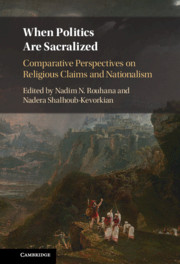Book contents
- When Politics Are Sacralized
- When Politics Are Sacralized
- Copyright page
- Contents
- Figures
- Maps
- Tables
- Contributors
- Preface and Acknowledgments
- 1 A Comparative Perspective on Religious Claims and Sacralized Politics
- Part I Israel
- Part II India
- Part III Sri Lanka
- Part IV Serbia
- Part V Iran
- Part VI Saudi Arabia and Wahhabism
- Part VII Northern Ireland
- Part VIII Palestine
- Index
- References
Part V - Iran
Published online by Cambridge University Press: 10 June 2021
- When Politics Are Sacralized
- When Politics Are Sacralized
- Copyright page
- Contents
- Figures
- Maps
- Tables
- Contributors
- Preface and Acknowledgments
- 1 A Comparative Perspective on Religious Claims and Sacralized Politics
- Part I Israel
- Part II India
- Part III Sri Lanka
- Part IV Serbia
- Part V Iran
- Part VI Saudi Arabia and Wahhabism
- Part VII Northern Ireland
- Part VIII Palestine
- Index
- References
Summary

- Type
- Chapter
- Information
- When Politics are SacralizedComparative Perspectives on Religious Claims and Nationalism, pp. 245 - 272Publisher: Cambridge University PressPrint publication year: 2021

